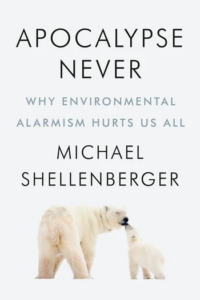There is no doubt that the problem of dramatic high energy prices has been exacerbated by tensions with Russia and financial speculation. Yet bills had been rising for some time before the Russians began massing troops along the border with Ukraine. Why? The answer is simple and has found expression in Italy in two words: ecological transition. The "green" agenda of quick and total conversion to renewable energy in order to zero emissions of CO2. The one that will be reconfirmed next week in Egypt at the COP27.
This agenda will not only result in more expensive bills. Beyond certain sweetened and apologetic visions, it will lead to a profound overhaul of our way of life: an overhaul that for the bulk of the population will result in lower living standards. It is striking how little is debated about the outcomes of this green agenda and the premises that motivated it: the gloomy predictions that global warming will lead to the end of the world.
Symptomatic of this guilty, culpable superficiality of Italian public opinion is that two books against the tide, signed by authoritative pens, were published in the U.S. between 2020 and 2021, but that only one found an Italian edition - and it did so without sparking any debate, despite the relevancy and meaningfulness of the topic.
Let us therefore give the reader an account of this, illustrating what these two works tell us.
Michael Shellenberger vs Greta&Co.

The cover
The first is Apocalypse never. Why environmental alarmism hurts us all by Michael Shellenberger, published in America by HarperCollins in 2020 and translated into Italian by Marsilio in 2021 under the title L’apocalisse può attendere.
Shellenberger, an anthropologist by background, is a "heavy" name in American environmentalism. In 2008, "Time" magazine listed him among its 30 "environmental heroes." This year he ran in the election for governor of California, finishing third, despite having no party affiliation. He has published op-eds in "New York Times," "Washington Post" and "Wall Street Journal." He has been a leader in several environmental NGOs. For the past two decades, however, he has been critical of the dominant strand of environmentalism.
Apocalypse never is probably the book where he best explained the reasons for such aversion. In his view, that kind of environmentalists ranging from Greenpeace to Greta Thunberg hides, behind the well-known green veneer, other underlying ideal motivations: anti-capitalism, Malthusianism, crypto-religious yearning that induces one to want to see the impending apocalypse in order to feel part of something great.
Economic development is good for the environment
Shellenberger explains that modernity and economic growth are a boon to the environment: urbanization, intensive agriculture, and synthetic materials have allowed reforestation and saved animal species (such as turtles, elephants, and whales) from what seemed certain extinction. In contrast, environmentalist crusades such as the one against plastics have the only effect of having to go back to plundering nature to replace it: you know the plastic packaging that is disappearing from our supermarkets, to the benefit of paper packaging - to produce which you have to cut down trees? There; and producing paper bags or glass bottles in place of the corresponding plastic ones emits more CO2 as well. Bioplastics, while being more biodegradable, are less reusable and recyclable, and so we end up having to produce more of them, increasing waste, energy consumption and emissions.
Shellenberger's pen mercilessly debunks many myths of environmentalism: from the Amazon "lung of the Earth" (in reality, the oxygen it produces is consumed by itself: 60 percent in plant respiration, 40 percent by microbes) to the deforestation of the globe (in the past 35 years, tree growth has outpaced its loss), from the danger of plastics in the oceans (recent studies reveal that its degradation is much faster than we thought and can be further speeded up with special additives) to pollution in the air (air quality in developed countries has improved dramatically since 1950, thanks to new technologies to burn coal, the transition to natural gas and environmentally friendly vehicles).
The real green choice? Nuclear power
One of Shellenberger's historic battles is the one in favor of nuclear power, which most environmentalists, on the other hand, dislike. The California author explains how the advancement of man and his standard of living has come about through the transition from lower energy density (energy per unit volume) to higher density sources: from wood, then, to coal and then to oil and gas. Increased energy efficiency means less land devastation (for wood you have to cut down forests, for coal you dig a mine, for oil a well) and less CO2 emission. The next step, Shellenberger explains, would be nuclear power, which is an even more efficient and cleaner energy source. But ideological opposition has taken over at this point: environmentalists prefer renewables, i.e., going back to using the power of the sun or wind, as in pre-industrial times. Going from the 2000-6000 watt/m2 density of gas and nuclear power plants to the 50 watt/m2 of solar power plants.
Solar and wind power, however, is unreliable and unpredictable: the wind often does not blow, the sun is often covered by clouds (in addition to not being there at night). Its use in the energy mix greatly raises the cost of electricity because it requires 100% support of gas-fired plants (to make up for times when wind and sun are absent), new and extensive power lines (a wind power plant requires 450 times more land than a gas-fired one), extra personnel and material for operation and maintenance (a solar power plant compared to a nuclear power plant requires 16 times more material and produces 300 times more waste - containing toxic substances to date disposed of by burying them in poor countries).
Storing the energy produced from renewables to have it available even when there is a shortage of wind and sun would require an unrealistic number of batteries: it has been calculated that with $900 billion enough storage centers would be built to power the U.S. power grid ...for four hours. A hypothetical full U.S. switch to solar and wind would require an expenditure, in batteries alone, of 23 trillion (in one year the entire federal budget is 6/7 trillion). Not to mention land use: today the U.S. energy system requires 0.5 percent of the national land; if it would shift entirely to renewables, it would need between 25 and 50 percent.
Nuclear power is more competitive than renewables. This is evidenced by the fact that, between 1965 and 2018, $2 trillion was invested globally in nuclear power and $2,300 in solar and wind power: yet, at the end of the time frame, the output of nuclear power was twice that of renewables.
Why do environmentalists oppose nuclear power? Follow the money...
Nuclear power, in short, offers the only opportunity to remove coal, oil and gas from our lives. But then why do environmentalists oppose it so fiercely? Is it perhaps because of its danger? Accidents at nuclear power plants have resulted in very low casualties compared to those caused by accidents at oil wells, gas pipelines or dams. In fact, nuclear power, by avoiding the poisonous emissions inherent in fossil and biomass, saves countless lives. It is only the misinformation of anti-nuclearists that has the public falsely convinced to the contrary; but such misinformation also serves to push for ever more obsessive regulation of the industry, the purpose of which is to make nuclear power too expensive to keep outperforming renewables.
Shellenberger makes two hypotheses to explain environmentalists' seemingly mindless opposition to nuclear power. The first, laid out with extensive documentation regarding some of America's largest environmental NGOs, is - very simply - that environmentalists are funded by billionaires who make money from fossil energy. While nuclear power could replace hydrocarbons, gas and oil will always remain necessary to make up for the structural shortcomings of solar and wind. In spite of urban legends that would have oil majors busy funding "climate change denialism," today organizations pushing for energy transition to renewables (but not nuclear) cash in far more than those critical of the "green" agenda. Agenda that, for that matter, can be fruitful for many: when President Obama spent 150 billion on his Green New Deal, a sizable chunk ended up in out-of-pocket contributions for billionaires who had financed his campaign.
Environmentalism, neo-Malthusianism, and death cult
Shellenberger's second hypothesis is more conceptual and appeals to environmentalists' need to make sense of their lives, seeing themselves as saviors of the world. Environmentalism should be interpreted as the elites' dominant religion: belief in an invisible order (nature), a meaning to individual and collective life (saving the planet), the division of humanity into good and evil (environmentalists versus "climate deniers"), a priestly caste in charge of moralizing sermons (the scientists). If an easy solution to the problem they struggle against were at hand, their role would be greatly diminished. That is why the most obvious solution - nuclear power - is so much annoying for environmentalists. Psychology - if not psychiatry - would thus explain this paradoxical reversal of terms: the problem they say they are fighting becomes their reason for living and, as such, it is vital that it continues to exist. Environmentalism is a death cult that cannot do without the bogeyman of extermination.
After World War II, the fashionable problem was that of overpopulation. Neo-Malthusians painted a bleak, almost apocalyptic picture of it. But when birthrate growth peaked and began to decline, many prominent neo-Malthusians - Shellenberger narrates in his book - continued to advertise the same recipe (i.e., decreasing birthrates and consumption), with the same millenarian accents, only pointing to climate as the new structural limit to human civilization. Such is the case with Bill McKibben, the first popularizer of the apocalyptic version of climate change with his 1989 book The end of nature. In it he borrowed the neo-Malthusian agenda of the previous decade, calling for a halt to economic growth, for "sustainable development" and the redistribution of wealth from rich to poor countries. In the name of "sustainable development," over the next 30 years NGOs succeeded in blocking funding for agricultural modernization, industrialization and electrification of the Third World, under the guise of "not harming the environment."
Apocalypse is fake news
Was it really just a pretext, or was it and still is an inescapable necessity? - the reader might ask. After all, if indeed the world is headed toward a cataclysm, toward an authentic end of the world, as environmentalists à la Greta Thunberg denounce, then any countermeasure is legitimate and justified. Even one that causes the extermination of birds and insects (such as wind turbines) or the underdevelopment of large regions of the globe (such as "sustainable development"). And this is where another fundamental argument of Apocalypse never comes into play (the one that gives the work its title): the apocalyptic scenarios projected by organizations such as Extinction Rebellion (those of the roadblocks, to be clear), according to which "there will be billions of deaths and the collapse of civilization," are made up out of thin air. No studies, not even the worst predictions of the IPCC (International Panel on Climate Change, which has been condensing the findings of climate science at the UN since 1988), support such a conclusion. The theory of the sixth mass extinction, which would be caused by humans, bases its calculations on the areal model of species whose validity has been disproved for a decade; it also clashes with the historical fact that only 0.8 percent of existing species have gone extinct since 1500.
The California-based author details how scholars have found numerous errors in the IPCC's reports over the years. Richard Tol, one of the world's top-rated economists and an expert on energy and climate economics, as well as one of the IPCC's authors, has denounced how they compete in being the most catastrophic in order to increase the chances that the media will quote just their side of the report. As if that were not enough, it is the IPCC itself - which is an intergovernmental body, not an academic one - that compiles the report summary in the most apocalyptic tone possible. This is because of the political pressure it receives: as revealed by Tol, European countries are more active in demanding alarmism in order to be able to justify emission-cutting measures in the eyes of the public.
Michael Shellenberger's criticisms of the IPCC and the apocalyptic view of climate change could be dismissed, prejudicially, on the grounds that he is not a climatologist but an anthropologist; an outspoken activist, but not a scientist for a living. And this is where the second book we want to bring to the reader's attention comes in, the work of an academic and man of science whose expertise cannot be belittled and ignored. The discussion of this work will be the subject of the second part of this article.
(to be continued)
Founder and President of Centro Studi Machiavelli. A graduate in History (University of Milan) and Ph.D. in Political Studies (Sapienza University), he teaches “History and Doctrine of Jihadism” at Marconi University and “Geopolitics of the Middle East” at Cusano University, where he has also taught on Islamic extremism in the past.
From 2018 to 2019, he served as Special Advisor on Immigration and Terrorism to Undersecretary for Foreign Affairs Guglielmo Picchi; he later served as head of the technical secretariat of the President of the Parliamentary Delegation to the Central European Initiative (CEI).
Author of several books, including Immigration: the reasons of populists, which has also been translated into Hungarian.









Scrivi un commento